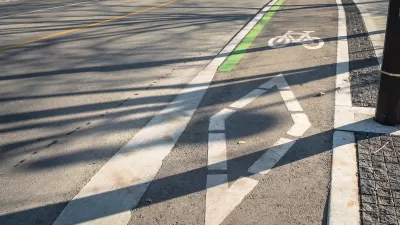Denver is in the process of rolling out a transportation experiment to the residents of the region: separating street space for transit and active transportation can serve all users and doesn't have to be the end of the world for drivers either.

Jon Murray checks in with the transportation situation on Broadway south of Downtown Denver, where last summer the city installed a two-way bike lane and removed a lane of vehicle traffic between Bayaud and Virginia avenues. According to Murray, Broadway funnels the heaviest traffic out of Downtown—about 32,000 drivers use the street every day. As "frustrating" as the changes have been for some rivers, writes Murray, the changes were welcomed by bike advocates and the change "is a signal of the future of commuting in Denver."
"As the city grapples with a surging population, intensifying traffic at all hours of the day and high demand for driving alternatives, public works officials increasingly are dividing up precious pavement, ending the decades of supremacy enjoyed by cars," according to Murray.
The pilot project on Broadway provides proof of concept, according to local transportation planners, that reducing traffic lanes doesn't necessarily slow travel times for cars, while it increases the potential capacity of the road. With evidence of the lane's success in serving all users (not just "auto-driving suburbanites," as Ken Schroeppel, an assistant professor in urban planning at the University of Colorado Denver, puts it in the article) in place, the city is preparing to expand the transit and bike lanes on the street.
FULL STORY: Denver’s commuter corridors, including Broadway, are no longer just for cars. Will that cause strife?

Trump Administration Could Effectively End Housing Voucher Program
Federal officials are eyeing major cuts to the Section 8 program that helps millions of low-income households pay rent.

Planetizen Federal Action Tracker
A weekly monitor of how Trump’s orders and actions are impacting planners and planning in America.

Ken Jennings Launches Transit Web Series
The Jeopardy champ wants you to ride public transit.

New Mexico Aging Department Commits to Helping Seniors Age ‘In Place’ and ‘Autonomously’ in New Draft Plan
As New Mexico’s population of seniors continues to grow, the state’s aging department is proposing expanded initiatives to help seniors maintain their autonomy while also supporting family caregivers.

USDOT Waters Down Self-Driving Car Regulations
The agency is reducing reporting requirements for autonomous vehicles and cars with self-driving features, prompting concern among safety advocates who say transparency is essential to the safe deployment of AV technology.

‘Minnesota Nice’ Isn’t so Nice When You Can’t Find a Place to Live
The Economic Development and Housing Challenge Program can help address the scourge of homelessness among Indigenous people.
Urban Design for Planners 1: Software Tools
This six-course series explores essential urban design concepts using open source software and equips planners with the tools they need to participate fully in the urban design process.
Planning for Universal Design
Learn the tools for implementing Universal Design in planning regulations.
Heyer Gruel & Associates PA
Ada County Highway District
Institute for Housing and Urban Development Studies (IHS)
City of Grandview
Harvard GSD Executive Education
Toledo-Lucas County Plan Commissions
Salt Lake City
NYU Wagner Graduate School of Public Service




























